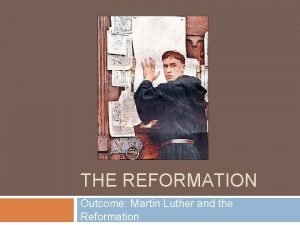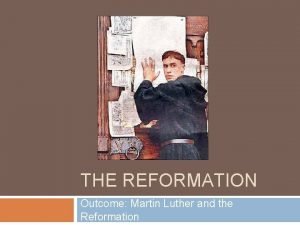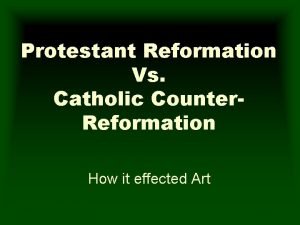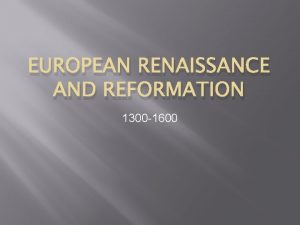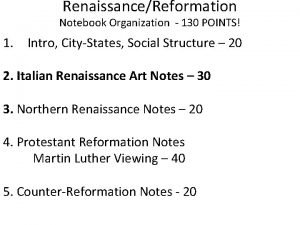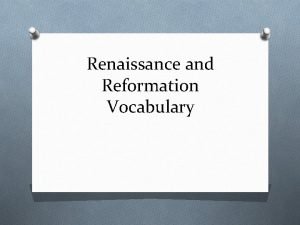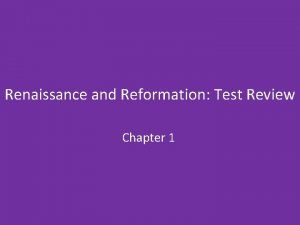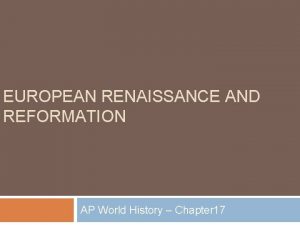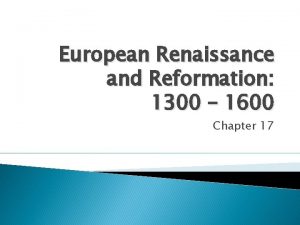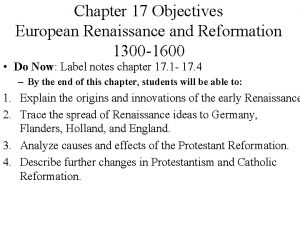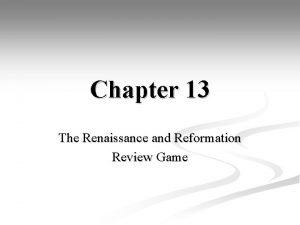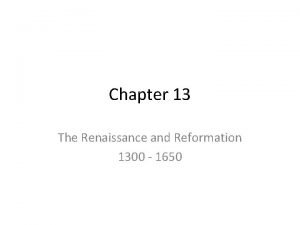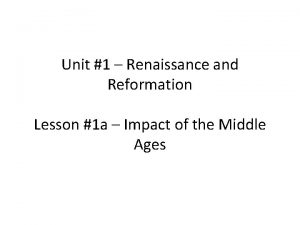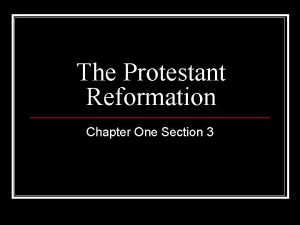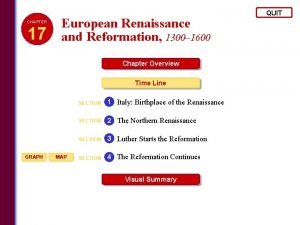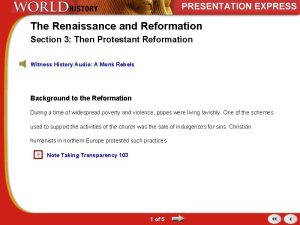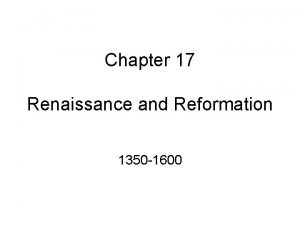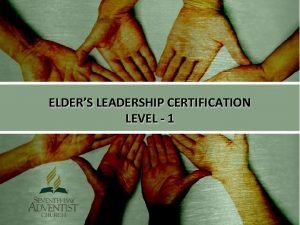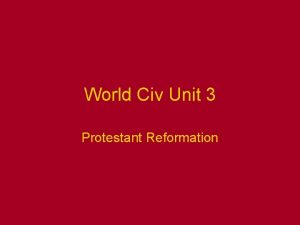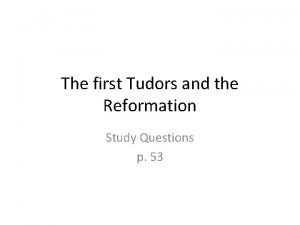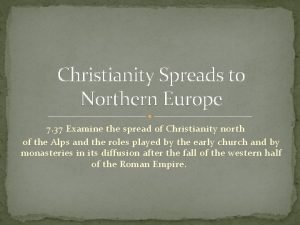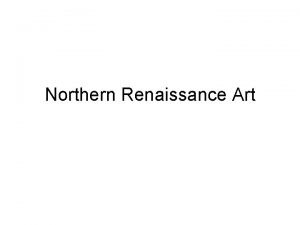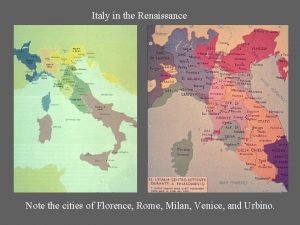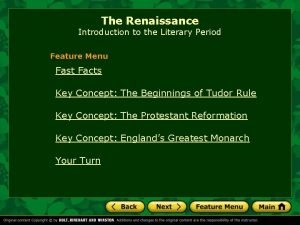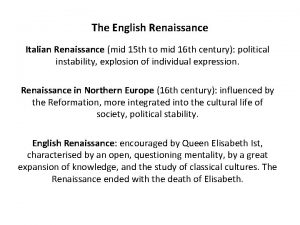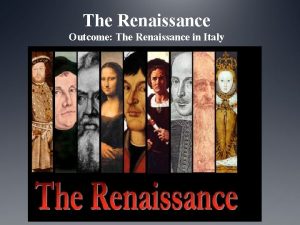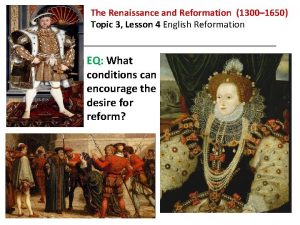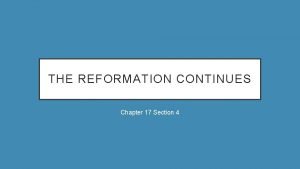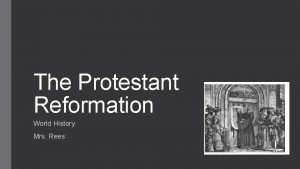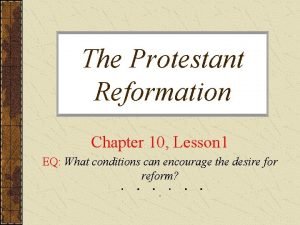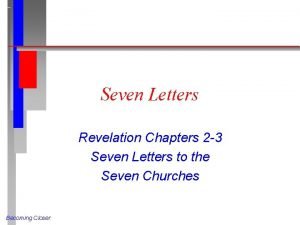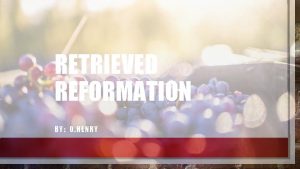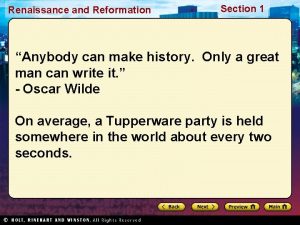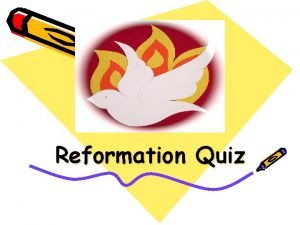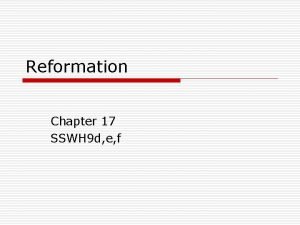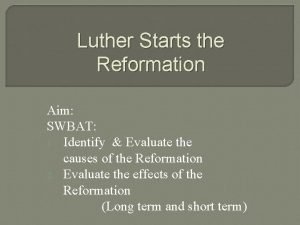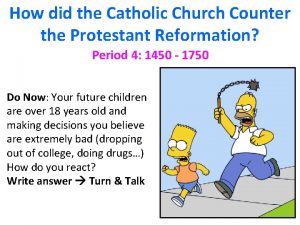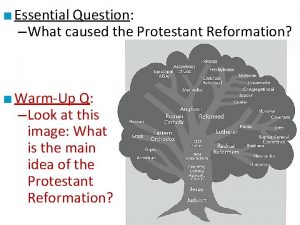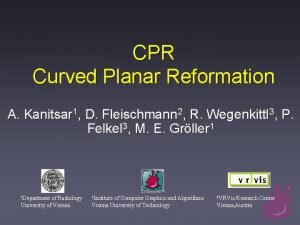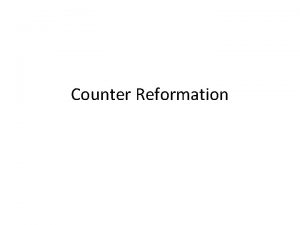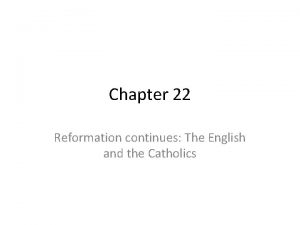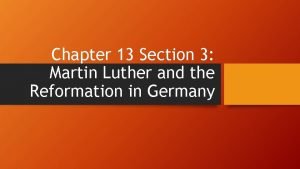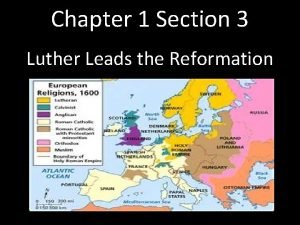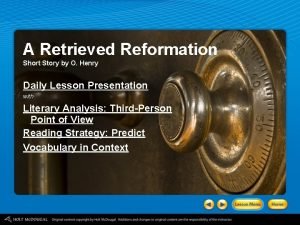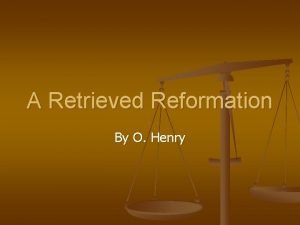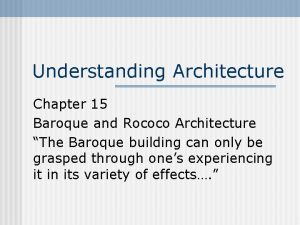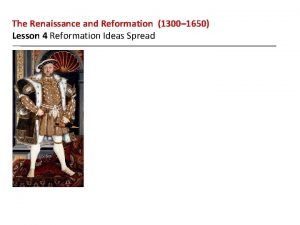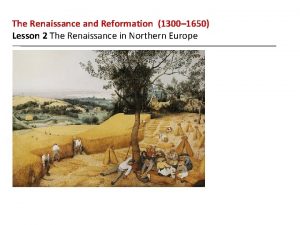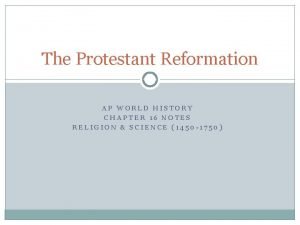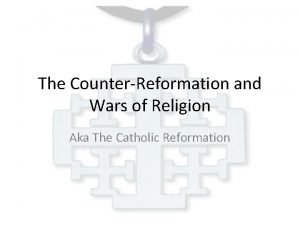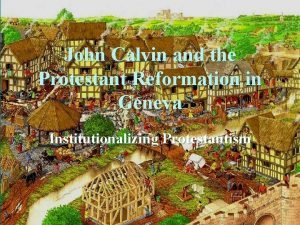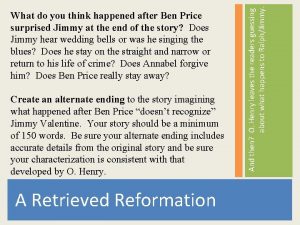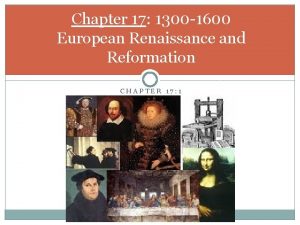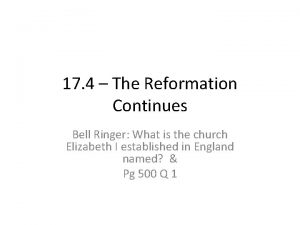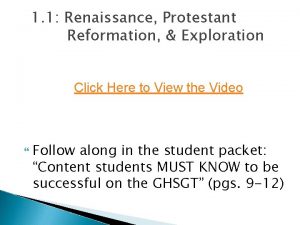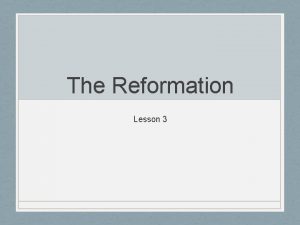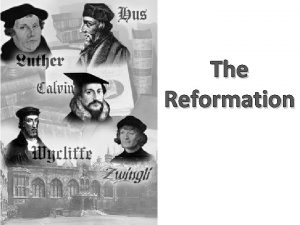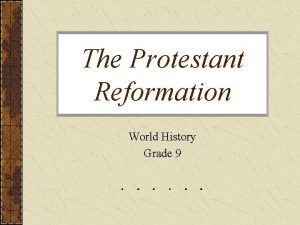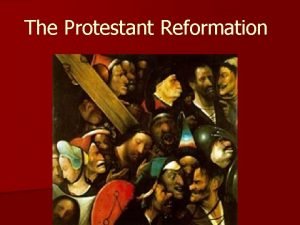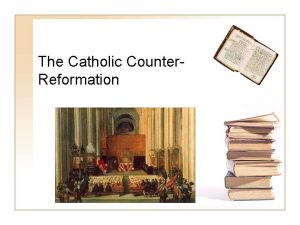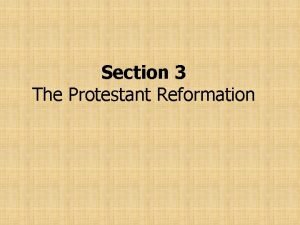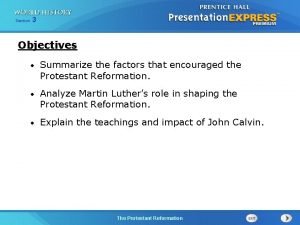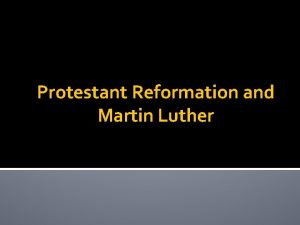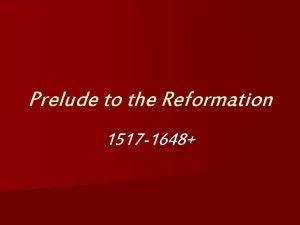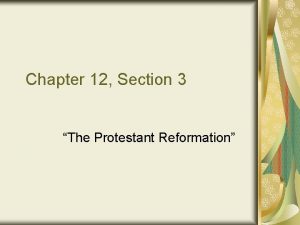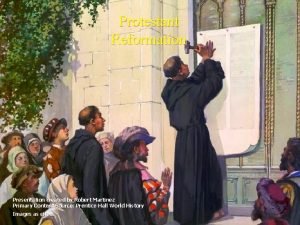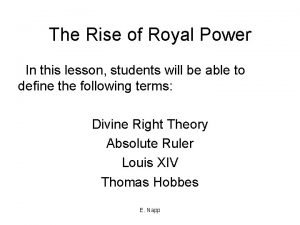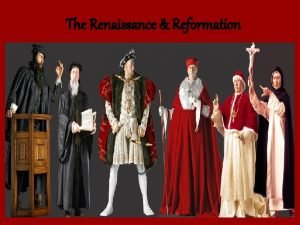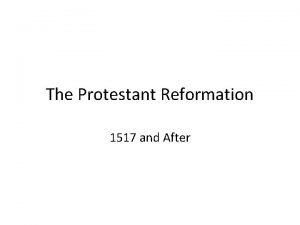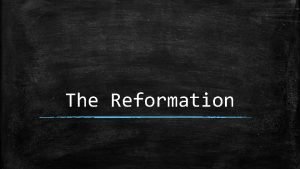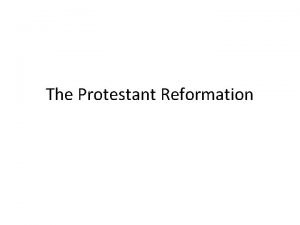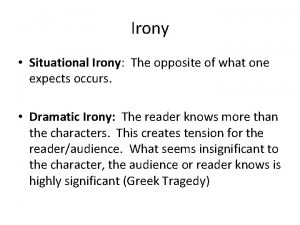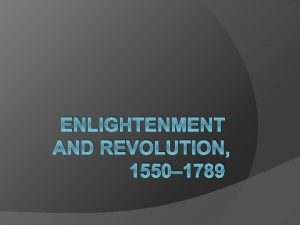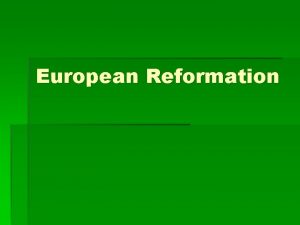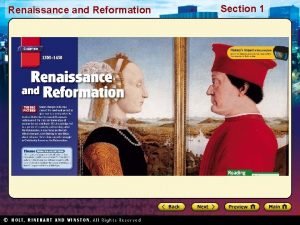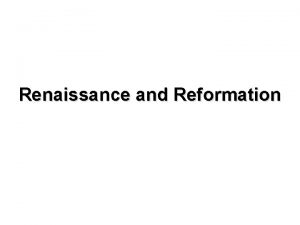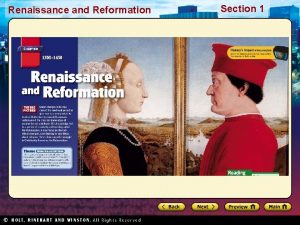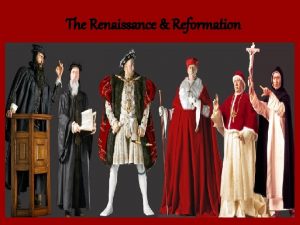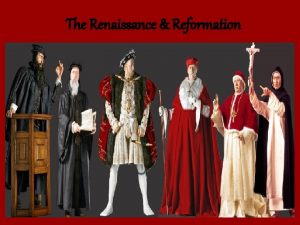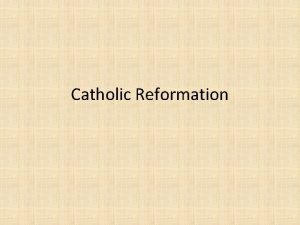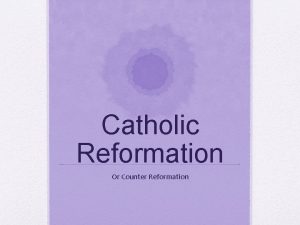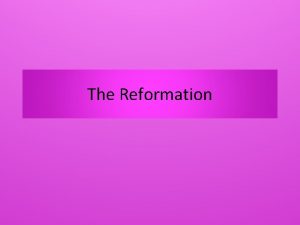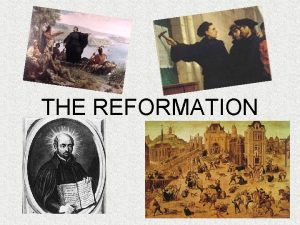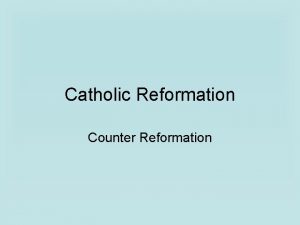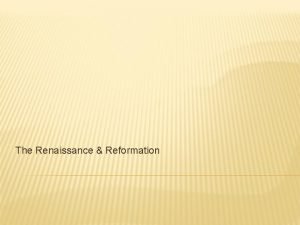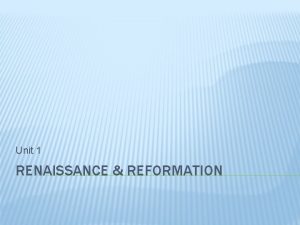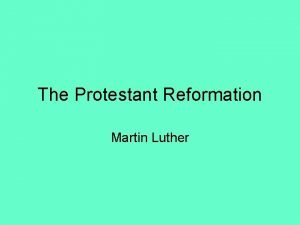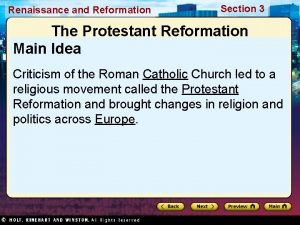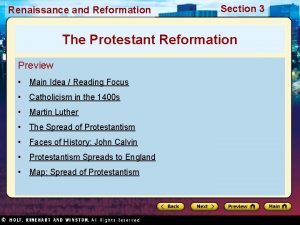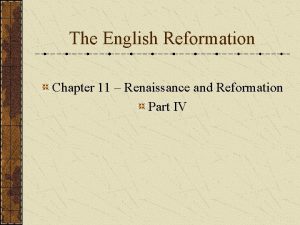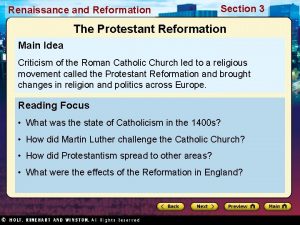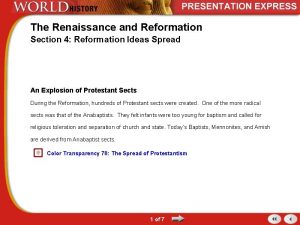THE RENAISSANCE AND REFORMATION THE RENAISSANCE Renaissance or



























































































- Slides: 91

THE RENAISSANCE AND REFORMATION

THE RENAISSANCE Renaissance or rebirth, started in Italy between 1350 and 1550. The Italian Renaissance is a period in which a number of people who lived in Italy believed they witnessed the rebirth of the ancient Greek and Roman worlds. What are the most important characteristics of the Renaissance?

ESSENTIAL QUESTIONS � What changes in society and in cities stimulated the beginning of the Renaissance? � What ideas formed the foundation for the Italian Renaissance? � What contributions did artists make to the Renaissance?



Renaissance Characteristics 1 st- Within this growing urban society, a secular, or worldly, viewpoint emerged as increasing wealth created new enjoyment of material things. 2 nd-the R. was an age of recovery from the disasters of the fourteenth century-the plague, political instability, and a decline of Church power. The recovery went hand in hand with a rebirth of interest in ancient culture.

3 rd- The final main characteristic of the R. is the emphasis of individual ability. A high regard for human worth and a realization of what individuals could achieve created a new social ideal Leon Batista Alberti, a 15 th century Italian, said, “Men can do all things if they will. ” Leonardo da Vinci, for example was a painter, sculptor, architect, inventor, and mathematician.


THE ITALIAN STATES The lack of a single strong ruler made it possible for a number of city states in northern and central Italy to remain independent. Milan, Venice, and Florence-expanded and played crucial roles in Italian politics. The Italian city-states prospered from flourishing trade that had expanded in the Middle Ages. Italian merchants also profited from the Crusades.

MILAN Milan was one of the richest city-states in Italy. It was located in the north, at the crossroads of the main trade routes from Italian coastal cities to the Alpine passes. In the 14 th century, members of the Visconti family established themselves as dukes of Milan. They extended their power over all of Lombardy.


MILAN The last Visconti ruler of Milan died in 1447. Francesco Sforza (SFAWRT sah) then conquered the city and became its duke. Sforza led a band of mercenaries- soldiers who fought for the highest bidders.

VENICE Venice was another major northern Italian citystate. As a link between Asia and Western Europe, the city drew traders from all over the world. Officially Venice was a republic with an elected leader called a doge. In reality, a small group of wealthy merchant-aristocrats ran the government.

FLORENCE The republic of Florence dominated the region of Tuscany. During the 14 th century, a small but wealthy group of merchants established control of the Florentine government. They waged a series of successful wars against their neighbors and established Florence as a major city-state.

FLORENCE AND THE MEDICI FAMILY In 1434, Cosimo de’ Medici took control of the city. The wealthy Medici family ran the government form behind the scenes. He would rule Florence until is death in 1464, where his son Piero de’ Medici would take over. Piero would rule Florence for five years until is death and was succeeded by his son, Lorenzo.

MEDICI FAMILY Lorenzo de’ Medici, governed from 1469 to 1492, dominated the city when Florence was the cultural center of Italy. He used his wealth to support artists, architects, and writers. As a result of Florence’s prosperity and fame, Lorenzo was known as “the Magnificent. ” Frustrated by the economic decline, the Medici family turned over the rule to to a Dominican minister.

MACHIAVELLI No one gave better expressions to the Italian’s love affair with political power than Niccoló Machiavelli. His book The Prince is one of the most influential works on political power in the Western world. The central thesis in The Prince concerns how to acquire and keep political power. Before Machiavelli’s book, many writers stressed that in order to keep political power the ruler must have Christian values. Machiavelli rejected this idea and believed that morality had little to do with politics.

THE PRINCE From Machiavelli’s point of view, a prince’s attitude toward power must be based on an understanding of human nature, which he believed was basically self-centered. A prince acts on behalf of the state. According to Machiavelli, for the state’s sake, a leader must do good when possible but evil when necessary. Machiavelli abandoned morality as the basis for analyzing political activity and argued that the ends justify the means.

RENAISSANCE SOCIETY Although, the social order of three classes continued into the R. some changes became evident. The Nobility Nobles, old and new dominated society by 1500 s. They made up only 2 to 3 percent of the population in most countries, the nobles held important political posts and served as advisers to the king.

RENAISSANCE SOCIETY The Nobility In The Book of the Courtier, Baldassare Castiglione described the characteristics of a perfect Renaissance noble. First, a noble was born, not made. He was expected to have character, grace, and talent. Second, the perfect noble had to develop two basic skills. Military or Physical exercises and was expected to gain a classical education and enrich his life with arts. Third, the noble needed to follow a certain standard of conduct.

PEASANTS AND TOWNSPEOPLE In the Renaissance, they still constituted 85 to 90 percent of the total European population , except in the highly urban areas of northern Italy and Flanders. By 1500, especially in western Europe, more and more peasants became legally free. Townspeople made up the rest of the third estate.

FAMILY AND MARRIAGE The family bond was a source of great security in the dangerous urban world of Renaissance Italy. To maintain the family, parents carefully arranged marriages, often to strengthen business or family ties. Some marriages were arranged while the children were just two or three years old. The most important aspect of the marriage contract was the size of the dowry, a sum of money given by the wife’s family to the husband upon marriage.


FAMILY AND MARRIAGE Father-husband was the center of the Italian family. He gave it his name, managed all finances(his wife had no share in his wealth), and made the decisions that determined his children’s lives. A father’s authority over his children was absolute until he died or formally freed his children. In R. Italy, children did not become adults on reaching a certain age. Instead, adulthood came to children when their fathers went to a judge and freed them.

IDEAS AND ART OF THE RENAISSANCE

DEVELOPMENT OF HUMANISM Humanism was based on the study of the classics, the literary works of ancient Greece and Rome. Humanist studied grammar, rhetoric, poetry, moral philosophy, and history. Today these subjects are called the humanities. Petrarch, known as the father of the Italian Renaissance humanism, did more to foster its development in the 14 th century than any other individual.

Petrarch, looked forgotten Latin manuscripts and set in motion a search for similar manuscripts in monastic libraries throughout Europe. 14 th century humanist like Petrarch had described the intellectual life as one of solitude. They rejected family and a life of action in the community.

VERNACULAR LITERATURE The humanist emphasis on classical Latin led to its widespread use in the writings of scholars, lawyers, and theologians. However, some writers wrote in the vernacular, or the language spoken in their own region, such as Italian, French, or German. In the 14 th century, the literary works of the Italian author Dante and the English author Geoffrey Chaucer helped make vernacular literature more popular.

DANTE Dante’s masterpiece in the Italian vernacular is the Divine Comedy. It is the story of the soul’s journey to salvation. The lengthy poem has three major sections: Hell, Purgatory, and Heaven, or Paradise. Dante is led on an imaginary journey through these three realms until he reaches Paradise, where he beholds God.

CHAUCER Chaucer used the English vernacular in his famous work The Canterbury Tales. His beauty of expression and clear language were important in making his dialect the chief ancestor of the modern English language. The Canterbury Tales consists of a collection of stories told by a group of 29 pilgrims journeying to the tomb of Thomas Becket at Canterbury, England.

RENAISSANCE EDUCATION The humanist movement had a profound effect on education in the 1300 s and 1400 s. Education became increasingly secular-focused less on religion. Renaissance humanists believed that education could dramatically change human beings. They wrote books on education and opened schools based on their ideas.

HUMANIST SCHOOLS At the core of humanist schools were the liberal studies. Humanists believed that liberal studies enabled individuals to reach their full potential. What were liberal studies? According to the humanists, students should study history, moral philosophy, eloquence, grammar and logic, poetry, mathematics, astronomy, and music.

HUMANIST SCHOOLS Humanist educators thought that education was a practical preparation for life. Its aim was not to create great scholars but complete citizens. Humanist education was also considered necessary for preparing the sons of aristocrats for leadership roles. Females were largely absent from these schools. The few female students who did attend humanist schools studied the classics and were encouraged to know some history, sing, ride, dance, and play a stringed instrument.

ITALIAN RENAISSANCE ART Frescoes by Masaccio are the first masterpieces of Early Renaissance (14001490) are. A fresco is a painting done on fresh, wet plaster with water-based paints. By mastering the laws of perceptive, Masaccio could create the illusion of three dimensions, leading to a new, realistic style.


SCULPTURE AND ARCHITECTURE The Renaissance produced equally stunning advances in sculpture and architecture. The sculptor Donatello studied the statues of the Greeks and Romans. His works included a realistic, free-standing figure of Saint George.

ARCHITECTURE The work of architect Filippo Brunelleschi was inspired by the buildings of classical Rome. His design of the church of San Lorenzo in Florence reflects this. The classical columns and rounded arches in the church’s design created an environment that does not overwhelm the worshipper, as Gothic cathedrals might.


HIGH RENAISSANCE MASTERS The Final stage of Italian Renaissance painting flourished between 1490 and 1520. The High Renaissance, is the period associated with Leonardo da Vinci, Raphael, and Michelangelo.

LEONARDO DA VINCI Leonardo mastered the art of realistic painting and even dissected human bodies to better understand their workings. However, he wanted to advance beyond such realism to create idealized forms that captured the perfection of nature and the individualperfection that could not be expressed fully by a realistic style.



RAPHAEL By the age of 25, Raphael was already one of Italy’s best painters. He was admired for his numerous madonnas (paintings of the Virgin Mary) Raphael is also known for his frescoes in the Vatican Palace. His School of Athens reveals a world balance, harmony, and order-the underlying principles of classical Greek and Roman art.

MICHELANGELO Michelangelo, an accomplished painter, sculptor, and architect, was another master of the High Renaissance. Fiercely driven by the his desire to create, he worked with great passion and energy on a remarkable number of projects. Michelangelo’s figures on the ceiling of the Sistine Chapel in Rome depict an ideal type of human being with perfect proportion. The more beautiful the body, the more godlike the figure.



NORTHERN ARTISTIC RENAISSANCE The most important northern school of art in the 1400 s was in Flanders, one of the Low Countries. The Flemish painter Jan van Eyck was among the first to use and perfect the technique of oil painting. With his oil paints, he could create striking realism in fine details as in his painting Giovanni Arnolfini and his Bride


THE PROTESTANT REFORMATION

CHRISTIAN HUMANISM During the second half of the 15 th century, the new classical learning that was part of Italian Renaissance humanism spread to northern Europe. From that came a movement called Christian Humanism, or Northern Renaissance humanism. The major goal of this movement was to reform the Catholic Church.

CHRISTIAN HUMANISM The Christian humanists believed in the ability of human beings to reason and improve themselves. They thought that if people read the classics, and especially the basic works of Christianity, they would become more pious. Christian humanists believed that in order to change society, they would first have to change human beings. They were loyal Catholics who wanted to restore the simple faith of the early church.

DESIDERIUS ERASMUS The best known Christian humanist was Desiderius Erasmus. He believed that people should use their reason to become better Christians. He called his view of religion “the philosophy of Christ” He believed it was more important that Christians be good in their everyday lives. By improving themselves, they would be able to reform the Church and society.

ERASMUS In 1509, Erasmus wrote a book called Praise of Folly. In his book, Erasmus humorously criticized aspects of the his society that he believed were most in need of reform. He especially attacked the wealth of Renaissance popes.

NEED FOR REFORM From 1450 to 1520, a series of popes-known as the Renaissance popes-failed to meet the Church’s spiritual needs. They were often more concerned with Italian politics and worldly interests than with spiritual matters. Julius II, the fiery “warrior-pope, ” personally led armies against his enemies. This disgusted Christians who viewed the pope as a spiritual, not a military, leader.


NEED TO REFORM While the leaders of the Church were failing to meet their responsibilities, ordinary people desired meaningful religious Expression and assurance of their salvation, or acceptance into Heaven An indulgence was a certificate issued by the church. The certificate granted a pardon for a person’s sins. Frederick the Wise, had amassed over 5, 000 relics. Indulgences attached to them could reduce time in purgatory by 1443 years. The Church also sound indulgences.

MARTIN LUTHER Martin Luther was a monk and a professor at the University of Wittenberg, in Germany, where he lectured on the Bible. Through his study of the Bible, Luther arrived at an answer to a problem-the certainty of salvation-that had bothered him since he had become a monk. Catholic teaching had stressed that both faith and good works were needed to gain personal salvation. In Luther’s opinion, human beings were powerless in the sight of an almighty God and could never do enough good works to earn salvation.

MARTIN LUTHER Luther came to believe that humans are not saved through the good works but through their faith in God. This idea, called justification by faith alone, became the chief teaching of the Protestant Reformation, or the religious reform movement that divided the western Church into Catholic and Protestant groups.

THE NINETY-FIVE THESES Luther did not see himself as a rebel, but he was greatly upset by the widespread selling of indulgences. Especially offensive in his eyes was the monk Johann Tetzel, who sold indulgences with the slogan: “As soon as the coin in the coffer rings, the sold from purgatory springs. ” On Oct. 31 st 1517, Luther angered by the Church’s practices, supposedly posted his Ninetyfive Theses on the door of the Castle Church in Wittenberg.

NINETY-FIVE THESES His theses were a stunning attack on abuses in the sale of indulgences. Thousands of copies of the 95 -Theses were printed and spread to all parts of Germany.

A NEW CHURCH EMERGES By 1520, Luther had begun to move toward a more definite break with the Catholic Church. He called on the German princes to overthrow the papacy in Germany and establish a reformed German church. Luther also attacked the Church’s system of sacraments. He would only keep two sacramentsbaptism and communion. He also went against the long-standing Catholic requirement that the clergy remain celibate, or unmarried.

A NEW CHURCH EMERGES Through all these calls for change, Luther continued to emphasized his new doctrine of salvation. It is faith alone, he said, and not good works, that justifies and brings salvation through Christ. Unable to accept Luther’s ideas, the Church excommunicated him in Jan. 1521. By the Edict of Worms, Martin Luther was made an outlaw within the empire. His works were to be burned and Luther himself captured and delivered to the emperor.

LUTHERANISM During the next few years, Luther’s religious movement became a revolution. Typically the Catholic church was able to stop the spread of ideas they opposed, but this movement had the support of some three hundred leaders. Luther also set up new religious services to replace the Catholic mass. These services consisted of Bible readings, preaching the word of God, and song. Luther would marry a former nun. His marriage provided a model of the married and family life.

LUTHERANISM Luther’s doctrine soon became known as Lutheranism and the churches as Lutheran churches. Lutheranism was the first Protestant faith.

POLITICS IN THE GERMAN REFORMATION Of course there would not be any type of spread of Protestantism if it wasn’t connected to political affairs. The Holy Roman Empire was Catholic and covered much of central Europe. It included about 300 German states.


CHARLES V Charles V was a member of the powerful Habsburg dynasty, and came to inherit all of the family's land, making him the ruler of one extremely large empire. When he just one years old, he was already Duke of Burgundy and Lord of the Netherlands. Then, when we has six years old, he became King of Spain, being the first king to unite the crowns of Castille and Aragon. And finally, he was elected Holy Roman Emperor in 1519, cementing all of his possessions together into the Empire we know today. He also ruled Spain, the Netherlands, part of Italy, and territories in the Americans.

POLITICAL AND RELIGIOUS PROBLEMS Charles, like some other secular authorities saw the Reformation as a disrupting force. Charles hoped to preserve the unity of his empire by keep it Catholic. Politically, he wanted to keep the empire under the control of his dynasty-the Hapsburg. Charles launched a series of wars that lasted more than 20 years against Francis I, the king of Frances in which their were a number of disputes over territories.


PEACE OF AUGSBURG An end of religious warfare in Germany came in 1555 with the Peace of Augsburg. This agreement formally accepted the division of Christianity in Germany. The German states were now free to choose between Catholicism and Lutheranism. Lutheran states were to have the same rights as Catholic states. The choice was still not left to the people, but the ruler.

THE SPREAD OF PROTESTANTISM

ZWINGLIAN REFORMATION Ulrich Zwingli was a priest in Zürich. The city council of Zürich, strongly influenced by Zwingli, began to introduce religious reforms. Relics and images were abolished. All paintings and decorations were removed from the churches and replaced by whitewashed walls. A new church service consisting of Scripture reading, prayer, and sermons replaced the Catholic mass.

CALVIN AND CALVINISM John Calvin was born in France in 1509. Known for his sharp mind, Calvin studied law, humanism, and religion in Paris. He was especially interested in religion. Eventually, Calvin fled from Paris because it became too dangerous to talk about Protestantism. He finally found safety in Geneva, Switzerland. There, his powerful preaching convinced many people to follow him.

CALVINISM In 1536, Calvin published the Institutes of the Christian Religion, a summary of Protestant thought. He would immediately gain reputation as one of the new leaders of Protestantism. Calvin stood very close to Luther on the most important doctrines, he believed in the doctrine of justification by faith alone to explain how humans achieved salvation. However, Calvin also placed much emphasis on the allpowerful nature of God-what Calvin called the “power, grace, and glory of God. ”

CALVINISM Calvin’s emphasis on the all-powerful nature of God led him to other ideas. One of the ideas was predestination. This “eternal decree” as Calvin called it, meant that God had predestined some people to be saved (the elect) and others to be damned (the reprobate). Therefore, God has already chosen who will go to heaven and who will not.


REFORMATION IN ENGLAND The English Reformation was rooted in politics, not religion. King Henry VIII, wanted to divorce his first wife, Catherine of Aragon, with whom he had a daughter Mary, but no son. Since he needed a male heir, Henry wanted to marry Anne Boleyn. Impatient with the pope’s unwillingness to annul (declare invalid) his marriage to Catherine, Henry turned to England’s own church courts.

THE BREAK FROM ROME As the archbishop of Canterbury, head of the highest church court in England, Thomas Cranmer ruled in May 1533 that the king’s marriage to Catherine was “null and absolutely void. ” At the beginning of June, Anne was crowned queen. In 1534, at Henry’s request, Parliament moved to finalize the break of the Catholic Church in England with the pope in Rome. The Act of Supremacy of 1534 declared that the king was “the only supreme head on earth of the new Church of England. ”

THE BREAK FROM ROME Henry used his new powers to dissolve the monasteries and sell their land possessions to landowners and merchants. Additionally, the king received a boost to his treasury. In matters of doctrine, however, Henry remained close to Catholic teachings. After Henry’s death in 1547, he was succeeded by Edward VI, his nine year old son by his third wife. During Edwards reign, church officials moved the Church of England, or Anglican Church, in a Protestant direction.

A LOOK AT HENRY VIII’S WIVES

BLOODY MARY Edward VI would reign for seven years until his death in 1553. Before his death, Edward would try to make sure his sister, Mary I, would not gain the throne. He designed for his cousin, Jane, to take over. Mary would lead a group against Jane, and would take over the crown in late 1553. Mary did not agree with her father’s split with the Roman Catholic Church. She would later bring the Church of England back under Catholicism during her reign. She also reversed the decision that stated her parents’ marriage was void.

BLOODY MARY Mary is was given the nickname “Bloody Mary” after executing more than 300 Protestants. The move back to Catholicism was short-lived after Mary’s death, when the sister she had prisoned for over a year took the crown, Elizabeth I. Elizabeth would be the last monarch of the Tudor dynasty. Her sympathy for the Protestant movement as well as opposition from Mary’s reign would lead to Protestantism full control of religion in England.


ANABAPTISTS Some people strongly disliked giving the state dominate roles in church affairs. These radicals were known as the Anabaptists. To Anabaptist, the true Christian church was a voluntary community of believers who had undergone spiritual rebirth and had then been baptized. Anabaptist also believed in following the practices and the spirit of early Christianity. They considered all believers equal. Each Anabaptist church chose its own minister, or spiritual leader.

ANABAPTIST Anabaptist also believed in the complete separation of church and state. They refused to hold political office or bear arms, because many took literally the biblical commandment “Thou shall not kill. ” Their political and religious beliefs caused them to be regarded as dangerous radicals who threatened the very fabric of sixteenth-century society.

REFORMATION AND SOCIETY Women role during the Reformation did not change. Luther stated it clearly: “The rule remains with the husband, and the wife is compelled to obey him by God’s command. ” Obedience wasn’t a woman’s only role. Her other important duty was to bear children, which both Calvin and Luther saw as a part of the divine plan.

ANTI-SEMITISM Martin Luther expected Jews to convert to Lutheranism during the Reformation, when they did not he wrote that Jewish synagogues and houses be destroyed.

CATHOLIC REFORMATION The Catholic Church saw a change in the sixteenth century, giving it new strength and enabling it to regain most of what had been lost. Three chief pillars-the Jesuits, reform of the papacy, and the Council of Trent-supported the Catholic Reformation.

CATHOLIC REFORMATION The Jesuits founded by Ignatius of Loyola, was a religious group which vowed absolute loyalty to the pope. They would be successful in spreading Catholicism to Germany, eastern Europe, and other parts of the world. Pope Paul III saw the need for change and in 1537 appointed a Reform Commission to determine the church’s wrongdoing. The commission determined that the Church’s problems were from the popes’ corrupt polices.

CATHOLIC REFORMATION Beginning in March 1545, a group of cardinals, archbishops, abbots, and theologians met off and on for 18 years in the city of Trent. They decreed faith and good works necessary for salvation. Clerical celibacy and the seven sacraments were upheld as well as the belief in purgatory and indulgences.

 The reformation outcome: martin luther and the reformation
The reformation outcome: martin luther and the reformation The reformation outcome martin luther and the reformation
The reformation outcome martin luther and the reformation Catholic reformation vs counter reformation
Catholic reformation vs counter reformation Who wrote praise of folly
Who wrote praise of folly Lutheranism and calvinism
Lutheranism and calvinism Renaissance and reformation interactive notebook
Renaissance and reformation interactive notebook Renaissance and reformation vocabulary
Renaissance and reformation vocabulary A thriving trading region where the renaissance began
A thriving trading region where the renaissance began European renaissance and reformation answer key
European renaissance and reformation answer key Chapter 17 european renaissance and reformation
Chapter 17 european renaissance and reformation European renaissance and reformation chapter 17
European renaissance and reformation chapter 17 Chapter 13 the renaissance and reformation
Chapter 13 the renaissance and reformation Chapter 13 renaissance and reformation
Chapter 13 renaissance and reformation Unit 4 lesson 1 the renaissance
Unit 4 lesson 1 the renaissance The protestant reformation worksheet answers
The protestant reformation worksheet answers Chapter 17 european renaissance and reformation
Chapter 17 european renaissance and reformation Chapter 12 renaissance and reformation
Chapter 12 renaissance and reformation The renaissance and reformation section 3 quiz
The renaissance and reformation section 3 quiz Chapter 17 renaissance and reformation
Chapter 17 renaissance and reformation Revival and reformation
Revival and reformation Protestant beliefs
Protestant beliefs Luther leads the reformation
Luther leads the reformation The first tudors and the reformation
The first tudors and the reformation Cosimo de' medici
Cosimo de' medici Italian renaissance vs northern renaissance venn diagram
Italian renaissance vs northern renaissance venn diagram The renaissance outcome renaissance painters/sculptors
The renaissance outcome renaissance painters/sculptors Italian vs northern renaissance
Italian vs northern renaissance Renaissance vs high renaissance
Renaissance vs high renaissance The renaissance introduction to the renaissance answer key
The renaissance introduction to the renaissance answer key Italian renaissance vs english renaissance
Italian renaissance vs english renaissance The renaissance outcome the renaissance in italy
The renaissance outcome the renaissance in italy Reformation
Reformation Chapter 17 section 4 the reformation continues
Chapter 17 section 4 the reformation continues Reformation rap
Reformation rap What were the final decrees of the council of trent
What were the final decrees of the council of trent Chapter 3 lesson 1 the protestant reformation
Chapter 3 lesson 1 the protestant reformation Protest reformation 1517 1648
Protest reformation 1517 1648 Reformation
Reformation Climax of three little pigs
Climax of three little pigs Reformation
Reformation How did martin luther start the protestant reformation quiz
How did martin luther start the protestant reformation quiz Reformation def
Reformation def Luther starts the reformation
Luther starts the reformation Reformation
Reformation What caused the protestant reformation?
What caused the protestant reformation? Curved planar reformation
Curved planar reformation Counter reformation
Counter reformation Ch3li
Ch3li Reformation summary
Reformation summary Chapter 17 section 4 the reformation continues
Chapter 17 section 4 the reformation continues Chapter 13 section 3 the protestant reformation
Chapter 13 section 3 the protestant reformation Chapter 17 section 3 luther leads the reformation
Chapter 17 section 3 luther leads the reformation What is the point of view of a retrieved reformation?
What is the point of view of a retrieved reformation? Retrieved reformation
Retrieved reformation Chapter 15 section 1 world history
Chapter 15 section 1 world history What was the counter-reformation?
What was the counter-reformation? Unit 12 lesson 4 reformation ideas spread
Unit 12 lesson 4 reformation ideas spread The reformation in europe lesson 2
The reformation in europe lesson 2 Kaozheng ap world history
Kaozheng ap world history What was the counter-reformation?
What was the counter-reformation? New testament reformation fellowship
New testament reformation fellowship Why was john calvin important to the reformation
Why was john calvin important to the reformation How to write an alternative ending to a story
How to write an alternative ending to a story What was the counter-reformation?
What was the counter-reformation? Chapter 17 section 4 the reformation continues answer key
Chapter 17 section 4 the reformation continues answer key What was the counter-reformation?
What was the counter-reformation? The catholic reformation lesson 3
The catholic reformation lesson 3 Corruption in the church during the reformation
Corruption in the church during the reformation Crash course protestant reformation
Crash course protestant reformation The protestant reformation crossword puzzle
The protestant reformation crossword puzzle Was the counter reformation successful?
Was the counter reformation successful? A major goal of the counter reformation was to
A major goal of the counter reformation was to What factors encouraged the protestant reformation?
What factors encouraged the protestant reformation? Unit 3: martin luther & the protestant reformation
Unit 3: martin luther & the protestant reformation Why did martin luther criticize the roman catholic church
Why did martin luther criticize the roman catholic church Prelude to reformation
Prelude to reformation Unit 12 lesson 3 the protestant reformation
Unit 12 lesson 3 the protestant reformation Protestant reformation
Protestant reformation Protestant reformation
Protestant reformation Reformation of the deadbeat noble chapter 5
Reformation of the deadbeat noble chapter 5 Protestant reformation map
Protestant reformation map Chapter 17 section 3 luther leads the reformation
Chapter 17 section 3 luther leads the reformation Protestant reformation kahoot
Protestant reformation kahoot Ulrich zwingli was a leader of the reformation in ______.
Ulrich zwingli was a leader of the reformation in ______. Opposite of situational
Opposite of situational How did the reformation help spur the scientific revolution
How did the reformation help spur the scientific revolution Magisterial reformation
Magisterial reformation Hát kết hợp bộ gõ cơ thể
Hát kết hợp bộ gõ cơ thể Frameset trong html5
Frameset trong html5 Bổ thể
Bổ thể Tỉ lệ cơ thể trẻ em
Tỉ lệ cơ thể trẻ em Voi kéo gỗ như thế nào
Voi kéo gỗ như thế nào
